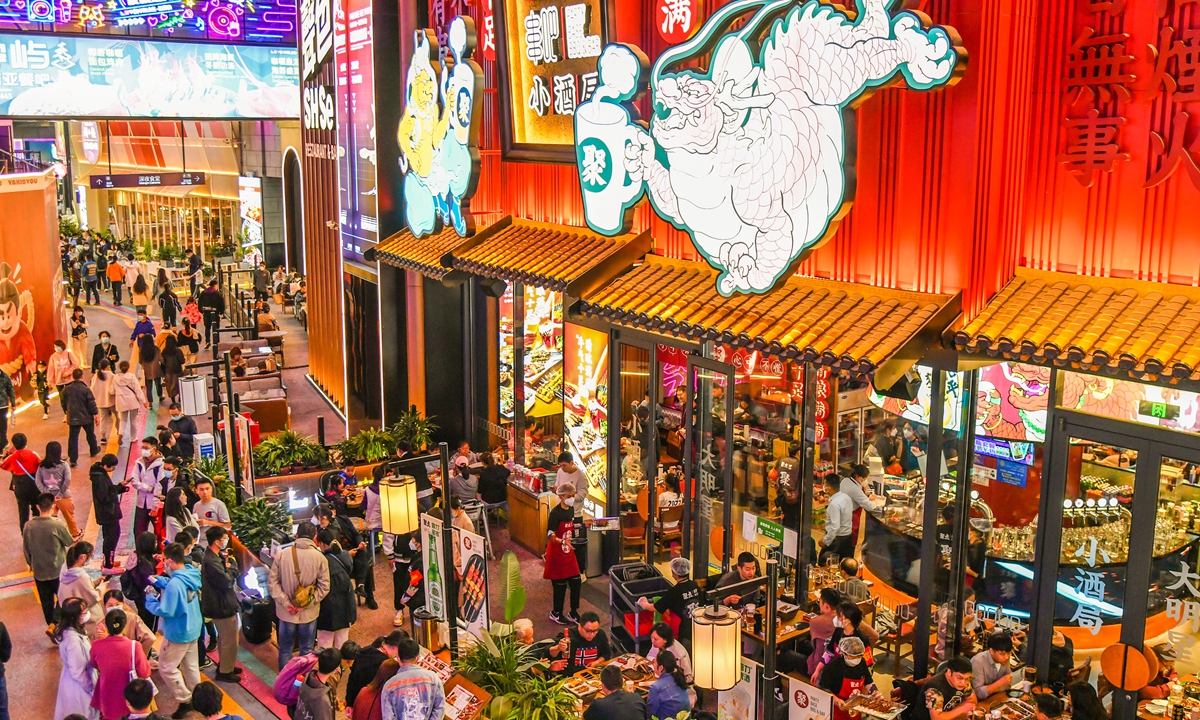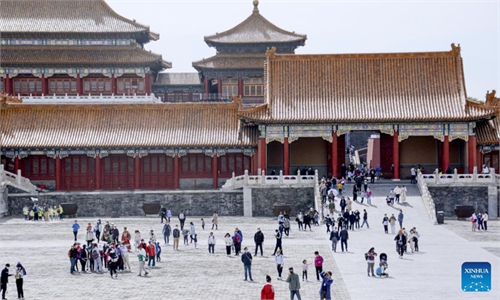China puts out vibrant travel numbers during National Day holidays with unwavering epidemic control

People shop and dine at a shopping mall in Beijing's Wukesong area on October 6, 2022, during the weeklong National Day holidays. Photo: VCG
The weeklong National Day holidays ending Friday bear witness to China's vibrant tourism, recreation and retail activities during the festival season, as the country's two-pronged strategy - funneling more vitality into its economy while keeping up with precise epidemic control - comes to fruition.
The just-concluded holidays, shortly ahead of the 20th National Congress of the Communist Party of China (CPC), came across as especially patriotic with red tourism becoming one of the trendiest phrases over the holidays. Among the hottest trends was a surge in local tourism spending as leisure and recreation options in local and surrounding areas prevailed, according to the latest data.
The tourism vibrancy, adding to positive hospitality and retail numbers, is considered to anchor the economy toward a sustained recovery on the premise of effective epidemic control.
Inspiring travel
The imminent five-yearly Party Congress imbued this past National Day holidays with an overwhelming national pride, rendering patriotism-themed activities one of the highlights of the holiday season.
A typical example was huge crowds waiting overnight to watch an early morning national flag-raising ceremony at Tian'anmen Square in Beijing on October 1, the first day of the weeklong festival.
A 19-year-old university student in Beijing who preferred to be called Kaikai was among the crowds, reportedly more than 220,000, that quickly made headlines on Chinese social media including Sina Weibo, Douyin and Xiaohongshu.
Kaikai and six other fellow students joined the queue at 11 pm the previous night and arrived at the square around 1 am. About five hours later, when Tian'anmen Square embraced the first rays of the morning sun, the bugle call for raising the flag was sounded, and then the national anthem was played, with the audience singing aloud, he told the Global Times on Friday, recalling the moment.
"As the five-starred red flag rose slowly against the morning light, my heart was filled with pride of the increasingly prosperous motherland," he remarked.
Tian'anmen Square, where a giant flower basket was installed and slogans celebrating the festival and welcoming the CPC National Congress were prominent, was among the most-visited attractions in Beijing.
Additionally, other red attractions in the capital were popular. The museum in Beijing tailored for showcasing the CPC's early revolutionary activities was almost fully booked each day throughout the National Day holidays, the Beijing Daily reported on Friday.
Red tourism has become the new mainstream of urban holiday lifestyles, the report said, citing Tang Chengcai, a professor with the School of Tourism Sciences of Beijing International Studies University.
The booming red tourism mirrors new demands of people's spiritual life, according to Tang. The country's vigorous support for red tourism development has given rise to premium red cultural products, and a slew of state achievements has fueled a spontaneous push to join the red tourism trend, the professor explained.
Nationwide, red tourist sites and activities in memory of revolutionary martyrs were hugely popular, the Chinese state broadcaster reported on Friday.
Along with the availability of more consumption scenarios incorporating technology and intangible cultural heritage, among others, into red tourism over this year's National Day holidays, red attractions came across as hotly pursued by young travelers, according to the China Tourism Academy.
Take the aforementioned Beijing museum. The museum hosted 1,318 visitors on October 1, with those under 30 hitting 871, an indication of a rising patriotic young generation.
Aside from the marked enthusiasm for red attractions, soaring outlays on local tourism made the past golden week different from its precedents.
Per capita expenditure on tourism in local and surrounding areas over this year's golden week rose nearly 30 percent compared with last year's National Day holidays, read results of a wrap-up report released Friday by domestic travel platform Ctrip.
Shanghai, Beijing, Guangzhou, Hangzhou and Shenzhen were named among the top cities where local tourism was most favored, per Ctrip data.
Buoyed by the rising preference toward local tourism, suburban hotels, hostels and inns and hotels nearby theme parks were sold out well ahead of the past golden week. Hotel bookings for local tourism cost nearly 10 percent more than the previous golden week, according to Ctrip. The fervor for camping tourism also continued, with bookings over the festival increasing over 10 times than the year before.
Sales of camping gear and equipment such as tents, canopies, hammocks, picnic mats surged 286.3 percent year-on-year during the National Day holidays, Chinese retailer Suning said in a note sent to the Global Times on Friday.
Sports travel has been popular among youngsters as part of a broader local tourism activity, domestic online travel agency Qunar said in a statement sent to the Global Times on Friday, citing a substantial spike in search volumes for cycling, hiking, boating, skiing, horseback riding and other sports activities.
Sustained recovery
The travel numbers, adding to retail, transport and box office statistics, painted an overall sustained recovery that befits the economy that keeps up with precise virus containment in light of continued Omicron flare-ups.
Domestic tourism trips amounted to 422 million over the seven-day festival, recovering to 60.7 percent of the 2019 level, data from the Ministry of Culture and Tourism showed on Friday.
Throughout the weeklong festival, passenger trips via railroad, highway, waterway and air were estimated to total more than 255 million, the state broadcaster reported Friday.
On the part of cinemas, the country's box office over the National Day holidays had topped 1.39 billion yuan ($195 million) as of Thursday night, according to data from Chinese ticketing app Maoyan.
In yet another sign of a consumption revival, culture and tourism-related consumption transactions between September 17 and October 6 hit 74.34 billion yuan, per figures from the Shanghai branch of China UnionPay. That involves 245 million transactions, a rise of 22.8 percent from the prior year.
Attesting to more economic vitality, the Caixin BBD new economy index was revealed earlier in October to have tallied 30.3 in September, meaning that new economy industries made up 30.3 percent of the country's total economic inputs. The reading was 0.4 percentage points higher than the previous month.
All these were seen as proof of an economy well in motion with a keen eye on effective virus control.
The current epidemic prevention measures for dynamic zero-COVID policy, including mass nucleic acid testing are one of the effective measures to curb the virus spreading, Zhuang Shilihe, a Guangzhou-based medical expert told the Global Times on Friday.
Preventing infection is a worldwide problem based on the current data as virus keeps mutating, experts noted.
As a subvariant of Omicron BA.5, BF.7 has enhanced immunity evasion compared with BA.5, which means that it is possible that people could be infected with BF.7 even if they have been infected before or have taken COVID-19 vaccines, Zhuang said.
The vaccines and oral antiviral pills used to treat COVID-19 are still effective toward BF.7, and the COVID-19 vaccines are effective at preventing severe cases and death from COVID-19, Zhuang continued, noting that residents are suggested to maintain good hygiene habits including wearing a facial mask and washing hands frequently.

